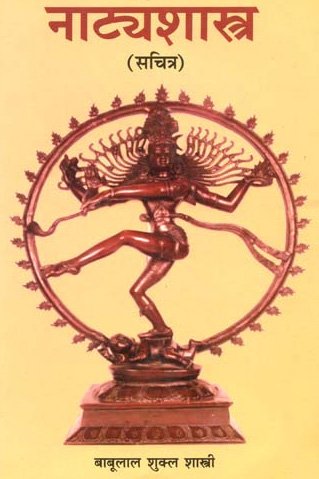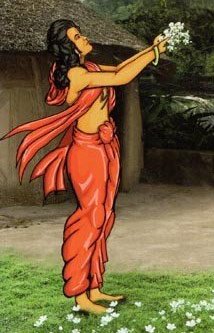Ullola: 16 definitions
Introduction:
Ullola means something in Hinduism, Sanskrit, Jainism, Prakrit, Buddhism, Pali. If you want to know the exact meaning, history, etymology or English translation of this term then check out the descriptions on this page. Add your comment or reference to a book if you want to contribute to this summary article.
In Hinduism
Natyashastra (theatrics and dramaturgy)
Source: Shodhganga: The significance of the mūla-beras (natya)Ullola means to “lift and fold one leg” and is one of the sixteen aṅgakiriyai (usage of the action of the body), which itself forms a division of Abhinaya or Avinaya (artistic expressions) as defined in the second book of the Pañcamarapu (‘five-fold traditional usage’) which represents an important piece of Tamil literature.—The Pañcamarapu (“five-fold traditional usage”) refers to a book on five established literary usages (five-fold traditional usages) defines terms such as Ullola. It was composed by Cerai Aṟivanār in the 9th century AD during the time of Pandyan Tirumaran of the last Caṅkam Period.

Natyashastra (नाट्यशास्त्र, nāṭyaśāstra) refers to both the ancient Indian tradition (shastra) of performing arts, (natya—theatrics, drama, dance, music), as well as the name of a Sanskrit work dealing with these subjects. It also teaches the rules for composing Dramatic plays (nataka), construction and performance of Theater, and Poetic works (kavya).
Kavya (poetry)
Source: archive.org: Naisadhacarita of SriharsaUllola (उल्लोल) refers to a “wave”, and is mentioned in the Naiṣadha-carita 7.1. Cf. Udayasundarīkatha, page 81.

Kavya (काव्य, kavya) refers to Sanskrit poetry, a popular ancient Indian tradition of literature. There have been many Sanskrit poets over the ages, hailing from ancient India and beyond. This topic includes mahakavya, or ‘epic poetry’ and natya, or ‘dramatic poetry’.
Shaktism (Shakta philosophy)
Source: Google Books: ManthanabhairavatantramUllola (उल्लोल) refers to “currents (of energy)” [?], according to the Ṣaṭsāhasrasaṃhitā, an expansion of the Kubjikāmatatantra: the earliest popular and most authoritative Tantra of the Kubjikā cult.—Accordingly, “(Kāmarūpa) is the Neuter (absolute) within the qualities. It has emerged as the pervasion (of consciousness) and, in front of the middle seat, is located on the peak in front. (Pleasing and delicate) like a lotus petal, it is radiant (with energy) and grey in colour. It shakes with mighty and fierce currents (of energy) engaged in striking against (it) and rocking (it) all around [i.e., mahā-pracaṇḍa-daṇḍa-ugra-sphālana-ullola-lālasa] as it dries up (the entire) universe. The all-pervasive Lord of Kula resides within (this), the maṇḍala of six spokes. There is nothing devoid of that within the sphere of emanation and withdrawal”.

Shakta (शाक्त, śākta) or Shaktism (śāktism) represents a tradition of Hinduism where the Goddess (Devi) is revered and worshipped. Shakta literature includes a range of scriptures, including various Agamas and Tantras, although its roots may be traced back to the Vedas.
In Jainism
General definition (in Jainism)
Source: archive.org: Een Kritische Studie Van Svayambhūdeva’s PaümacariuUllola (उल्लोल) participated in the war between Rāma and Rāvaṇa, on the side of the latter, as mentioned in Svayambhūdeva’s Paumacariu (Padmacarita, Paumacariya or Rāmāyaṇapurāṇa) chapter 57ff. Svayambhū or Svayambhūdeva (8th or 9th century) was a Jain householder who probably lived in Karnataka. His work recounts the popular Rāma story as known from the older work Rāmāyaṇa (written by Vālmīki). Various chapters [mentioning Ullola] are dedicated to the humongous battle whose armies (known as akṣauhiṇīs) consisted of millions of soldiers, horses and elephants, etc.

Jainism is an Indian religion of Dharma whose doctrine revolves around harmlessness (ahimsa) towards every living being. The two major branches (Digambara and Svetambara) of Jainism stimulate self-control (or, shramana, ‘self-reliance’) and spiritual development through a path of peace for the soul to progess to the ultimate goal.
Languages of India and abroad
Pali-English dictionary
Source: BuddhaSasana: Concise Pali-English Dictionaryullola : (m.) 1. commotion; 2. a big wave.
Source: Sutta: The Pali Text Society's Pali-English DictionaryUllola, (fr. ud + lul) — 1. a wave J. III, 228; VI, 394. ‹-› 2. commotion, unrest J. IV, 306, 476. (Page 156)

Pali is the language of the Tipiṭaka, which is the sacred canon of Theravāda Buddhism and contains much of the Buddha’s speech. Closeley related to Sanskrit, both languages are used interchangeably between religions.
Sanskrit dictionary
Source: DDSA: The practical Sanskrit-English dictionaryUllola (उल्लोल).—a. Violently moving, excessively tremulous; °स्खलित (skhalita) Mālatīmādhava (Bombay) 5.3; °कल्लोल (kallola) K.32 high or surging; Mv.5.2; लोल° (lola°) violently agitated or exercised; U. 3.36.
-laḥ A large wave or surge. उल्लोलसंक्रान्तविलोल- मूर्तिरुद्याति सिन्धोरुडुचक्रवर्ती (ullolasaṃkrāntavilola- mūrtirudyāti sindhoruḍucakravartī) Rām. ch.6.53.
Derivable forms: ullolaḥ (उल्लोलः).
Source: Cologne Digital Sanskrit Dictionaries: Shabda-Sagara Sanskrit-English DictionaryUllola (उल्लोल).—m.
(-laḥ) A surge, a large wave or billow. E. ud up, loḍ to be furious, ac affix, and ḍa becomes la.
Source: Cologne Digital Sanskrit Dictionaries: Cappeller Sanskrit-English DictionaryUllola (उल्लोल).—[adjective] dangling, swinging.
Source: Cologne Digital Sanskrit Dictionaries: Monier-Williams Sanskrit-English Dictionary1) Ullola (उल्लोल):—[=ul-lola] mfn. (ud-lo) (√lul), dangling, waving [commentator or commentary] on [Mahābhārata]
2) [from ul-lola] (also) lovely, [Dharmaśarmābhyudaya 2].
3) [v.s. ...] m. a large wave, [cf. Lexicographers, esp. such as amarasiṃha, halāyudha, hemacandra, etc.]
Source: Cologne Digital Sanskrit Dictionaries: Yates Sanskrit-English DictionaryUllola (उल्लोल):—[ullo+la] (laḥ) 1. m. A surge or wave.
Source: DDSA: Paia-sadda-mahannavo; a comprehensive Prakrit Hindi dictionary (S)Ullola (उल्लोल) in the Sanskrit language is related to the Prakrit word: Ullola.
[Sanskrit to German]
Sanskrit, also spelled संस्कृतम् (saṃskṛtam), is an ancient language of India commonly seen as the grandmother of the Indo-European language family (even English!). Closely allied with Prakrit and Pali, Sanskrit is more exhaustive in both grammar and terms and has the most extensive collection of literature in the world, greatly surpassing its sister-languages Greek and Latin.
Prakrit-English dictionary
Source: DDSA: Paia-sadda-mahannavo; a comprehensive Prakrit Hindi dictionary1) Ullola (उल्लोल) in the Prakrit language is related to the Sanskrit word: Ullul.
2) Ullola (उल्लोल) also relates to the Sanskrit word: Udlola.
3) Ullola (उल्लोल) also relates to the Sanskrit word: Ullola.
Prakrit is an ancient language closely associated with both Pali and Sanskrit. Jain literature is often composed in this language or sub-dialects, such as the Agamas and their commentaries which are written in Ardhamagadhi and Maharashtri Prakrit. The earliest extant texts can be dated to as early as the 4th century BCE although core portions might be older.
Kannada-English dictionary
Source: Alar: Kannada-English corpusUllōla (ಉಲ್ಲೋಲ):—[adjective] (said of waves) violently moving extremely tremulous.
--- OR ---
Ullōla (ಉಲ್ಲೋಲ):—
1) [noun] a violently rolling, highly risen, huge wave.
2) [noun] intense fervour or passion; impetuosity; vehemence.
--- OR ---
Ullōḷa (ಉಲ್ಲೋಳ):—[noun] = ಉಲ್ಲೋಲ [ullola]2.
--- OR ---
Uḷḷoḷa (ಉಳ್ಳೊಳ):—[noun] violent disturbance or commotion, esp. one accompanied by loud, confused noise, as of shouting; tumult; uproar.
Kannada is a Dravidian language (as opposed to the Indo-European language family) mainly spoken in the southwestern region of India.
See also (Relevant definitions)
Starts with: Ullolakallola, Ullolana.
Ends with: Catullola, Chatullola, Chatvullola, Dullola.
Full-text: Allolakallolam, Ullolakallola, Ullul, Udlola, Ulloleti, Ulva, Catullola, Ulladayati, Lul, Pracanda, Mahapracanda, Sphalana, Angakiriyai, Argala, Lola.
Relevant text
Search found 2 books and stories containing Ullola, Ul-lola, Ullōla, Ullōḷa, Uḷḷoḷa; (plurals include: Ullolas, lolas, Ullōlas, Ullōḷas, Uḷḷoḷas). You can also click to the full overview containing English textual excerpts. Below are direct links for the most relevant articles:
The Agni Purana (by N. Gangadharan)
Trishashti Shalaka Purusha Caritra (by Helen M. Johnson)
Appendix 2.3: new and rare words < [Appendices]